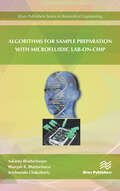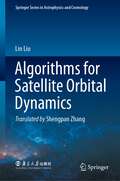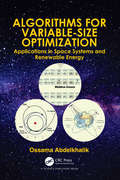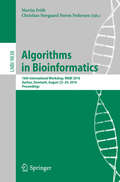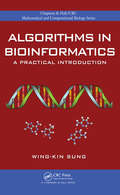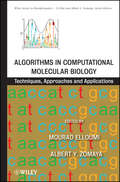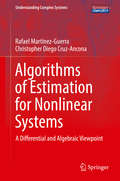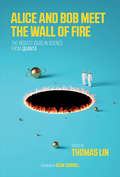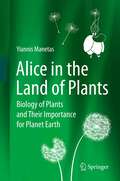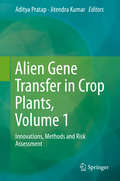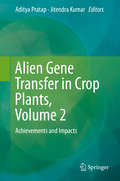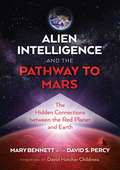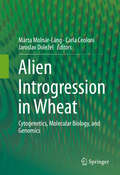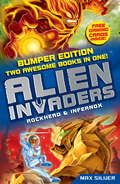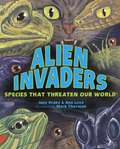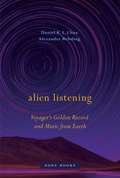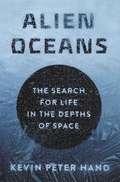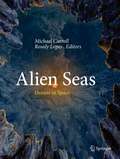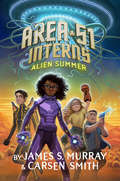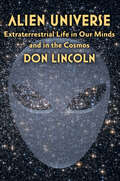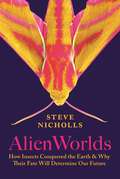- Table View
- List View
Algorithms for Sample Preparation with Microfluidic Lab-on-Chip
by Krishnendu Chakrabarty Bhargab B. Bhattacharya Sukanta BhattacharjeeRecent microfluidic technologies have brought a complete paradigm shift in automating biochemical processing on a tiny lab-on-chip (a.k.a. biochip) that replaces expensive and bulky instruments traditionally used in implementing bench-top laboratory protocols. Biochips have already made a profound impact on various application domains such as clinical diagnostics, DNA analysis, genetic engineering, and drug discovery, among others. They are capable of precisely manipulating micro-/pico-liter quantities of fluids, and provide integrated support for mixing, storage, transportation, and sensing, on-chip. In almost all bioprotocols, sample preparation plays an important role, which includes dilution and mixing of several fluids satisfying certain volumetric ratios. However, designing algorithms that minimize reactant-cost and sample-preparation time suited for microfluidic chips poses a great challenge from the perspective of protocol mapping, scheduling, and physical design. Algorithms for Sample Preparation with Microfluidic Lab-on-Chip attempts to bridge the widening gap between biologists and engineers by introducing, from the fundamentals, several state-of-the-art computer-aided-design (CAD) algorithms for sample preparation with digital and flow-based microfluidic biochips. Technical topics discussed in the book include: Basics of digital and flow-based microfluidic lab-on-chipComprehensive review of state-of-the-art sample preparation algorithmsSample-preparation algorithms for digital microfluidic lab-on-chipSample-preparation algorithms for flow-based microfluidic lab-on-chip
Algorithms for Satellite Orbital Dynamics (Springer Series in Astrophysics and Cosmology)
by Lin LiuThis book highlights the fundamental physics of orbit theory, dynamical models, methods of orbit determination, design, measurement, adjustment, and complete calculations for the position, tracking, and prediction of satellites and deep spacecraft. It emphasizes specific methods, related mathematical calculations, and worked examples and exercises. Therefore, technicians and engineers in the aerospace industry can directly apply them to their practical work. Dedicated to undergraduate students and graduate students, researchers, and professionals in astronomy, physics, space science, and related aerospace industries, the book is an integrated work based on the accumulated knowledge in satellite orbit dynamics and the author’s more than five decades of personal research and teaching experience in astronomy and aerospace dynamics.
Algorithms for Variable-Size Optimization: Applications in Space Systems and Renewable Energy
by Ossama AbdelkhalikMany systems architecture optimization problems are characterized by a variable number of optimization variables. Many classical optimization algorithms are not suitable for such problems. The book presents recently developed optimization concepts that are designed to solve such problems. These new concepts are implemented using genetic algorithms and differential evolution. The examples and applications presented show the effectiveness of the use of these new algorithms in optimizing systems architectures. The book focuses on systems architecture optimization. It covers new algorithms and its applications, besides reviewing fundamental mathematical concepts and classical optimization methods. It also provides detailed modeling of sample engineering problems. The book is suitable for graduate engineering students and engineers. The second part of the book includes numerical examples on classical optimization algorithms, which are useful for undergraduate engineering students. While focusing on the algorithms and their implementation, the applications in this book cover the space trajectory optimization problem, the optimization of earth orbiting satellites orbits, and the optimization of the wave energy converter dynamic system: architecture and control. These applications are illustrated in the starting of the book, and are used as case studies in later chapters for the optimization methods presented in the book.
Algorithms in Bioinformatics: 16th International Workshop, WABI 2016, Aarhus, Denmark, August 22-24, 2016. Proceedings (Lecture Notes in Computer Science #9838)
by Martin Frith Christian Nørgaard Storm PedersenThis book constitutes the refereed proceedings of the 16th International Workshop on Algorithms in Bioinformatics, WABI 2016, held in Aarhus, Denmark. The 25 full papers together with 2 invited talks presented were carefully reviewed and selected from 54 submissions. The selected papers cover a wide range of topics from networks, to phylogenetic studies, sequence and genome analysis, comparative genomics, and mass spectrometry data analysis.
Algorithms in Bioinformatics: A Practical Introduction (Chapman & Hall/CRC Computational Biology Series)
by Wing-Kin SungThoroughly Describes Biological Applications, Computational Problems, and Various Algorithmic Solutions Developed from the author's own teaching material, Algorithms in Bioinformatics: A Practical Introduction provides an in-depth introduction to the algorithmic techniques applied in bioinformatics. For each topic, the author clearly details the bi
Algorithms in Computational Molecular Biology
by Mourad Elloumi Albert Y. ZomayaThis book represents the most comprehensive and up-to-date collection of information on the topic of computational molecular biology. Bringing the most recent research into the forefront of discussion, Algorithms in Computational Molecular Biology studies the most important and useful algorithms currently being used in the field, and provides related problems. It also succeeds where other titles have failed, in offering a wide range of information from the introductory fundamentals right up to the latest, most advanced levels of study.
Algorithms of Estimation for Nonlinear Systems: A Differential and Algebraic Viewpoint (Understanding Complex Systems)
by Rafael Martínez-Guerra Christopher Diego Cruz-AnconaThis book acquaints readers with recent developments in dynamical systems theory and its applications, with a strong focus on the control and estimation of nonlinear systems. Several algorithms are proposed and worked out for a set of model systems, in particular so-called input-affine or bilinear systems, which can serve to approximate a wide class of nonlinear control systems. These can either take the form of state space models or be represented by an input-output equation. The approach taken here further highlights the role of modern mathematical and conceptual tools, including differential algebraic theory, observer design for nonlinear systems and generalized canonical forms.
Algorithms on Strings, Trees, and Sequences
by Dan GusfieldString algorithms are a traditional area of study in computer science. In recent years their importance has grown dramatically with the huge increase of electronically stored text and of molecular sequence data (DNA or protein sequences) produced by various genome projects. This 1997 book is a general text on computer algorithms for string processing. In addition to pure computer science, the book contains extensive discussions on biological problems that are cast as string problems, and on methods developed to solve them. It emphasises the fundamental ideas and techniques central to today's applications. New approaches to this complex material simplify methods that up to now have been for the specialist alone. With over 400 exercises to reinforce the material and develop additional topics, the book is suitable as a text for graduate or advanced undergraduate students in computer science, computational biology, or bio-informatics. Its discussion of current algorithms and techniques also makes it a reference for professionals.
Algorithms to Live By: The Computer Science of Human Decisions
by Brian Christian Tom GriffithsA fascinating exploration of how computer algorithms can be applied to our everyday lives, helping to solve common decision-making problems and illuminate the workings of the human mindAll our lives are constrained by limited space and time, limits that give rise to a particular set of problems. What should we do, or leave undone, in a day or a lifetime? How much messiness should we accept? What balance of new activities and familiar favourites is the most fulfilling? These may seem like uniquely human quandaries, but they are not: computers, too, face the same constraints, so computer scientists have been grappling with their version of such problems for decades. And the solutions they've found have much to teach us. In a dazzlingly interdisciplinary work, acclaimed author Brian Christian (who holds degrees in computer science, philosophy, and poetry, and works at the intersection of all three) and Tom Griffiths (a UC Berkeley professor of cognitive science and psychology) show how the simple, precise algorithms used by computers can also untangle very human questions. They explain how to have better hunches and when to leave things to chance, how to deal with overwhelming choices and how best to connect with others. From finding a spouse to finding a parking spot, from organizing one's inbox to understanding the workings of human memory, Algorithms to Live By transforms the wisdom of computer science into strategies for human living.
Alice and Bob Meet the Wall of Fire: The Biggest Ideas in Science from Quanta (The\mit Press Ser.)
by Thomas LinAccessible and essential coverage of today's challenging, speculative, cutting-edge science from Quanta Magazine.If you're a science and data nerd like me, you may be interested in "Alice and Bob Meet the Wall of Fire" and "The Prime Number Conspiracy" from Quanta Magazine and Thomas Lin. - Bill GatesThese stories reveal the latest efforts to untangle the mysteries of the universe. Bringing together the best and most interesting science stories appearing in Quanta Magazine over the past five years, Alice and Bob Meet the Wall of Fire reports on some of the greatest scientific minds as they test the limits of human knowledge. Quanta, under editor-in-chief Thomas Lin, is the only popular publication that offers in-depth coverage of today's challenging, speculative, cutting-edge science. It communicates science by taking it seriously, wrestling with difficult concepts and clearly explaining them in a way that speaks to our innate curiosity about our world and ourselves.In the title story, Alice and Bob—beloved characters of various thought experiments in physics—grapple with gravitational forces, possible spaghettification, and a massive wall of fire as Alice jumps into a black hole. Another story considers whether the universe is impossible, in light of experimental results at the Large Hadron Collider. We learn about quantum reality and the mystery of quantum entanglement; explore the source of time's arrow; and witness a eureka moment when a quantum physicist exclaims: “Finally, we can understand why a cup of coffee equilibrates in a room.” We reflect on humans' enormous skulls and the Brain Boom; consider the evolutionary benefits of loneliness; peel back the layers of the newest artificial-intelligence algorithms; follow the “battle for the heart and soul of physics”; and mourn the disappearance of the “diphoton bump,” revealed to be a statistical fluctuation rather than a revolutionary new particle. These stories from Quanta give us a front-row seat to scientific discovery.ContributorsPhilip Ball, K. C. Cole, Robbert Dijkgraaf, Dan Falk, Courtney Humphries, Ferris Jabr, Katia Moskvitch, George Musser, Michael Nielsen, Jennifer Ouellette, John Pavlus, Emily Singer, Andreas von Bubnoff, Frank Wilczek, Natalie Wolchover, Carl Zimmer
Alice in the Land of Plants: Biology of Plants and Their Importance for Planet Earth
by Yiannis ManetasWhy is it that plants do not need to move? How does a nonmotile organism have sex or defend itself? Why are some plants virtually immortal? What is the mechanism that allows plants to exploit a practically inexhaustible extraterrestrial energy source? How do plants regulate the composition of our planet's atmosphere? Why have there not been mass extinctions among plants as there have been among animals? How do plants communicate with one another? In the end, are plants intelligent organisms? These are some of the questions the author discusses to demonstrate that plants are wrongly considered to be simple organisms lacking specific behaviour and intelligence. This book promises to be as pleasant a surprise as Alice's experience in the white rabbit's warren, in which she encountered a world very different from ours. The author explains the biology of plants following Einstein's maxim that everything should be made as simple as possible, but not simpler.
Alien Gene Transfer in Crop Plants, Volume 1: Innovations, Methods and Risk Assessment
by Aditya Pratap Jitendra KumarGenetic engineering and biotechnology along with conventional breeding have played an important role in developing superior cultivars by transferring economically important traits from distant, wild and even unrelated species to the cultivated varieties which otherwise could not have been possible with conventional breeding. There is a vast amount of literature pertaining to the genetic improvement of crops over last few decades. However, the wonderful results achieved by crop scientists in food legumes’ research and development over the years are scattered in different journals of the World. <P><P> The two volumes in the series ‘Alien Gene Transfer in Crop Plants’ address this issue and offer a comprehensive reference on the developments made in major food crops of the world. These volumes aim at bringing the contributions from globally renowned scientists at one platform in a reader-friendly manner.<P><P> The 1st volume entitled, ‘Alien Gene Transfer in Crop Plants: Innovations, Methods and Risk Assessment” will deal exclusively with the process and methodology. The contents of this volume have been designed to appraise the readers with all the theoretical and practical aspects of wide hybridization and gene transfer like processes and methods of gene transfer, role of biotechnology with special reference to embryo rescue, genetic transformation, protoplast fusion and molecular marker technology, problems such as cross incompatibility and barriers to distant hybridization and solutions to overcome them. Since wild and weedy relatives of crop plants may have negative traits associated with them, there are always possibilities of linkage drag while transferring alien alleles. Therefore, problems and limitations of alien gene transfer from these species will also be discussed in this series. Further, the associated risks with this and assessment of risks will also be given due weightage.
Alien Gene Transfer in Crop Plants, Volume 2: Achievements and Impacts
by Aditya Pratap Jitendra KumarGenetic engineering and biotechnology along with conventional breeding have played an important role in developing superior cultivars by transferring economically important traits from distant, wild and even unrelated species to the cultivated varieties which otherwise could not have been possible with conventional breeding. There is a vast amount of literature pertaining to the genetic improvement of crops over last few decades. However, the wonderful results achieved by crop scientists in food legumes’ research and development over the years are scattered in different journals of the World. <P><P> The two volumes in the series ‘Alien Gene Transfer in Crop Plants’ address this issue and offer a comprehensive reference on the developments made in major food crops of the world. These volumes aim at bringing the contributions from globally renowned scientists at one platform in a reader-friendly manner. The second volume entitled, “Alien Gene Transfer in Crop Plants: Achievements and Impact” will deal more with the practical aspects. This volume will cover achievements of alien gene transfer in major food crops of the world and their impact on development of newer genetic variability and additional avenues for selection; development of superior cultivars for increased yield, resistance to biotic and abiotic stresses, improved nutritional and industrial quality; innovation of new techniques and positive as well as negative environmental implications. This volume has been divided into four groups with an aim to cover all major cereals, pulses, oilseeds and other crops (vegetable and horticultural crops) which are of economic importance.
Alien Intelligence and the Pathway to Mars: The Hidden Connections between the Red Planet and Earth
by Mary Bennett• Details how exploratory probes sent to Mars in the 1970s triggered a plethora of anomalous events, particularly crop circles (glyphs), and how these events are messages from ET intelligence to help us send a human mission to Mars • Reveals how the anomalous Cydonia region of Mars fits the Golden Ratio Spiral and looks at links between Martian formations and Earth&’s ancient sites • Illustrated throughout with color photographs, maps, and diagrams In this full-color study based on 25 years of research, Mary Bennett explores the ancient and modern connections between Mars and Earth as well as how extraterrestrial intelligences are trying to assist us in constructing a viable spacecraft to take a human crew swiftly and safely to Mars. She details how exploratory probes sent to Mars in the 1970s triggered over three decades of anomalous yet scientifically validated events, including crop circles, or crop glyphs. She explains how these formations, along with related events, encode advanced engineering concepts that offer solutions to the fundamental problems presently hindering long-haul crewed spaceflight--whether to the Moon, Mars, or beyond. Looking at the red planet itself, the author reveals the scientifically verifiable evidence pointing to intelligent design on the surface of Mars, specifically in the Cydonia region, which fits the Golden Ratio Spiral. She looks at the covert links between the Martian formations and Earth&’s ancient sites, such as the Avebury landscape in England and the Giza Complex. She describes how agencies concerned with space travel have been quietly mirroring areas of Mars through construction projects here on Earth, revealing that many of the ET messages have already been partially decoded. Taking you from a complex on Mars to the Teotihuacán pyramids in Mexico, from phi ratios to the Pentagon, from the Great Pyramid to quantum computing, this exploration of the hidden influence of Mars shows that our abilities as a future space-faring species began in the ancient past and are now coming to fruition.
Alien Introgression in Wheat: Cytogenetics, Molecular Biology, and Genomics
by Márta Molnár-Láng Carla Ceoloni Jaroslav DoleželThis book provides an overview of the latest advancements in the field of alien introgression in wheat. The discovery and wide application of molecular genetic techniques including molecular markers, in situ hybridization, and genomics has led to a surge in interspecific and intergeneric hybridization in recent decades. The work begins with the taxonomy of cereals, especially of those species which are potential gene sources for wheat improvement. The text then goes on to cover the origin of wheat, breeding in connection with alien introgressions, and the problems of producing intergeneric hybrids and backcross derivatives. These problems can include crossability, sterility, and unequal chromosome transmission. The work then covers alien introgressions according to the related species used, as well as new results in the field of genomics of wild wheat relatives and introgressions.
Alien Invaders (2 Books in 1): Two Book Bind-up
by Max SilverDiscover the explosive world of Alien Invaders in this awesome introduction to the series - featuring Cosmo's first two adventures in full! Travel at hyperspeed to the moon of Garr where you will battle the first invader ROCKHEAD, the living mountain. Then, fly your own Dragster 7000 spaceship to the jungle planet of Zaman, where you will battle the second invader INFERNOX, the firestarter!Complete with bonus games and puzzles - and fantastic gaming cards that allow you to do battle alongside Cosmo!
Alien Invaders: Species That Threaten Our World
by Jane Drake Ann LoveFrom killer toads, feral felines, and brown tree snakes to multiple invaders in Lake Victoria and the Great Lakes, Alien Invaders focuses on wave after wave of invaders that affect our ecosystems and the side-effects of climate change and modern global travel on our world today. Environmentalists and coauthors Jane Drake and Ann Love present the concepts of endangered species and biodiversity in this informative look at alien invaders and how they impact our world. From the days of sailing ships and shipboard rats to the fungus that sparked the Irish potato famine to the beautiful but deadly purple loosestrife strangling native wetlands, they examine extinctions and endangerments directly attributable to these alien invaders. Learn where the invaders originated, how they traveled, where they settled, what they displaced, why the invaded natural system was vulnerable, and what can be done. Kids can determine if they themselves are invaders or savers and how they can help. This exploration of a timely topic, coupled with the lively detailed illustrations of Toronto artist Mark Thurman, inspire kids and adults alike to be more observant and protective of our natural world.
Alien Life Imagined
by Mark BrakeOne day, astrobiologists could make the most fantastic discovery of all time: the detection of complex extraterrestrial life. As space agencies continue to search for life in our Universe, fundamental questions are raised: are we awake to the revolutionary effects on human science, society and culture that alien contact will bring? And how is it possible to imagine the unknown? In this book, Mark Brake tells the compelling story of how the portrayal of extraterrestrial life has developed over the last two and a half thousand years. Taking examples from the history of science, philosophy, film and fiction, he showcases how scholars, scientists, film-makers and writers have devoted their energies to imagining life beyond this Earth. From Newton to Kubrick, and Lucian to H. G. Wells, this is a fascinating account for anyone interested in the extraterrestrial life debate, from general readers to amateur astronomers and undergraduate students studying astrobiology.
Alien Listening: Voyager's Golden Record and Music from Earth
by Daniel K. Chua Alexander RehdingAn examination of NASA's Golden Record that offers new perspectives and theories on how music can be analyzed, listened to, and thought about—by aliens and humans alike.In 1977 NASA shot a mixtape into outer space. The Golden Record aboard the Voyager spacecrafts contained world music and sounds of Earth to represent humanity to any extraterrestrial civilizations. To date, the Golden Record is the only human-made object to have left the solar system. Alien Listening asks the big questions that the Golden Record raises: Can music live up to its reputation as the universal language in communications with the unknown? How do we fit all of human culture into a time capsule that will barrel through space for tens of thousands of years? And last but not least: Do aliens have ears?The stakes could hardly be greater. Around the extreme scenario of the Golden Record, Chua and Rehding develop a thought-provoking, philosophically heterodox, and often humorous Intergalactic Music Theory of Everything, a string theory of communication, an object-oriented ontology of sound, and a Penelopean model woven together from strands of music and media theory. The significance of this exomusicology, like that of the Golden Record, ultimately takes us back to Earth and its denizens. By confronting the vast temporal and spatial distances the Golden Record traverses, the authors take listeners out of their comfort zone and offer new perspectives in which music can be analyzed, listened to, and thought about—by aliens and humans alike.
Alien Oceans: The Search for Life in the Depths of Space
by Kevin HandInside the epic quest to find life on the water-rich moons at the outer reaches of the solar systemWhere is the best place to find life beyond Earth? We often look to Mars as the most promising site in our solar system, but recent scientific missions have revealed that some of the most habitable real estate may actually lie farther away. Beneath the frozen crusts of several of the small, ice-covered moons of Jupiter and Saturn lurk vast oceans that may have been in existence for as long as Earth, and together may contain more than fifty times its total volume of liquid water. Could there be organisms living in their depths? Alien Oceans reveals the science behind the thrilling quest to find out.Kevin Peter Hand is one of today's leading NASA scientists, and his pioneering research has taken him on expeditions around the world. In this captivating account of scientific discovery, he brings together insights from planetary science, biology, and the adventures of scientists like himself to explain how we know that oceans exist within moons of the outer solar system, like Europa, Titan, and Enceladus. He shows how the exploration of Earth's oceans is informing our understanding of the potential habitability of these icy moons, and draws lessons from what we have learned about the origins of life on our own planet to consider how life could arise on these distant worlds.Alien Oceans describes what lies ahead in our search for life in our solar system and beyond, setting the stage for the transformative discoveries that may await us.
Alien Seas: Oceans in Space
by Michael Carroll Rosaly LopesOceans were long thought to exist in all corners of the Solar System, from carbonated seas percolating beneath the clouds of Venus to features on the Moon's surface given names such as "the Bay of Rainbows" and the "Ocean of Storms." With the advent of modern telescopes and spacecraft exploration these ancient concepts of planetary seas have, for the most part, evaporated. But they have been replaced by the reality of something even more exotic. For example, although it is still uncertain whether Mars ever had actual oceans, it now seems that a web of waterways did indeed at one time spread across its surface. The "water" in many places in our Solar System is a poisoned brew mixed with ammonia or methane. Even that found on Jupiter's watery satellite Europa is believed similar to battery acid. Beyond the Galilean satellites may lie even more "alien oceans." Saturn's planet-sized moon Titan seems to be subject to methane or ethane rainfall. This creates methane pools that, in turn, become vast lakes and, perhaps, seasonal oceans. Titan has other seas in a sense, as large shifting areas of sand covering vast plains have been discovered. Mars also has these sand seas, and Venus may as well, along with oceans of frozen lava. Do super-chilled concoctions of ammonia, liquid nitrogen, and water percolate beneath the surfaces of Enceladus and Triton? For now we can only guess at the possibilities. 'Alien Seas' serves up part history, part current research, and part theory as it offers a rich buffet of "seas" on other worlds. It is organized by location and by the material of which various oceans consist, with guest authors penning specific chapters. Each chapter features new original art depicting alien seas, as well as the latest ground-based and spacecraft images. Original diagrams presents details of planetary oceans and related processes.
Alien Skies: Planetary Atmospheres from Earth to Exoplanets
by Frédéric J. PontPlanetary atmospheres are complex and evolving entities, as mankind is rapidly coming to realise whilst attempting to understand, forecast and mitigate human-induced climate change. In the Solar System, our neighbours Venus and Mars provide striking examples of two endpoints of planetary evolution, runaway greenhouse and loss of atmosphere to space. The variety of extra-solar planets brings a wider angle to the issue: from scorching "hot jupiters'' to ocean worlds, exo-atmospheres explore many configurations unknown in the Solar System, such as iron clouds, silicate rains, extreme plate tectonics, and steam volcanoes. Exoplanetary atmospheres have recently become accessible to observations. This book puts our own climate in the wider context of the trials and tribulations of planetary atmospheres. Based on cutting-edge research, it uses a grand tour of the atmospheres of other planets to shine a new light on our own atmosphere, and its relation with life.
Alien Summer #1 (Area 51 Interns)
by James S. Murray Carsen Smith"An exciting series opener."—Kirkus From the mind of Murr from the Impractical Jokers comes a new hilarious, action-packed series about a world of bizarre creatures, wacky gadgets, and four kid interns at the most interesting place on Earth: Area 51!It's the first day of summer vacation, and Viv Harlow just wants to relax with her friends at the beach before they all go to different high schools next year. She is definitely not interested in visiting her mom's office, even if Director Harlow works at the famous Area 51. But when an alarm sounds beneath the secret base and a whole race of aliens escape, she's about to get much more than she bargained for. Viv, Charlotte, Ray, and Elijah (who Viv is totally NOT crushing on) will have to work together, gear up with gadgets, and even protect a baby alien to save the day and defend Area 51.The debut middle-grade series from Murr of the Impractical Jokers, Area 51 Interns is filled with enough high-tech hijinks, bizarre creatures, and laugh-out-loud humor (plus an extra color insert full of gadgets) to make even alien skeptics hooked for more!
Alien Universe: Extraterrestrial Life in Our Minds and in the Cosmos
by Don LincolnAre alien civilizations really possible?If extraterrestrials exist, where are they? How likely is it that somewhere in the universe an Earth-like planet supports an advanced culture? Why do so many people claim to have encountered Aliens? In this gripping exploration, scientist Don Lincoln exposes and explains the truths about the belief in and the search for life on other planets.In the first half of Alien Universe, Lincoln looks to Western civilization's collective image of Aliens, showing how our perceptions of extraterrestrials have evolved over time. The roots of this belief can be traced as far back as our earliest recognition of other planets in the universe—the idea of them supporting life was a natural progression of thinking that has fascinated us ever since. Our captivation with Aliens has, however, led to mixed results. The world was fooled in the nineteenth century during the Great Moon Hoax of 1835, and many people misunderstood Orson Welles's 1938 radio broadcast, The War of the Worlds, leading to significant anxiety among some listeners. Our continuing interest in Aliens is reflected in entertainment successes such as E.T., The X-Files, and Star Trek.The second half of the book explores the scientific possibility of whether advanced Alien civilizations do exist. For many years, researchers have sought to answer Enrico Fermi’s great paradox—if there are so many planets in the universe and there is a high probability that many of those can support life, then why have we not actually encountered any Aliens? Lincoln describes how modern science teaches us what is possible and what is not in our search for extraterrestrial civilizations.Whether you are drawn to the psychological belief in Aliens, the history of our interest in life on other planets, or the scientific possibility of Alien existence, Alien Universe is sure to hold you spellbound.
Alien Worlds: How Insects Conquered the Earth, and Why Their Fate Will Determine Our Future
by Steve NichollsA beautifully illustrated journey into the hidden realm of insectsLife on Earth depends on the busy activities of insects, but global populations of these teeming creatures are currently under threat, with grave consequences for us all. Alien Worlds presents insects and other arthropods as you have never seen them before, explaining how they conquered the planet and why there are so many of them, and shedding light on the evolutionary marvels that enabled them to thrive. Blending glorious imagery with entertaining and informative science writing, this book takes you inside the hidden realm of insects and reveals why their fate carries profound implications for our own.Spectacular photos provide a rare, up-close look at the alien worlds of insectsSheds light on the origins and wondrous diversity of insectsDiscusses how insects first took to the air and colonised the far corners of our planetExplores the extraordinary sensory world of insectsExplains the remarkable success of social insects, from termites and ants to bees and wasps
